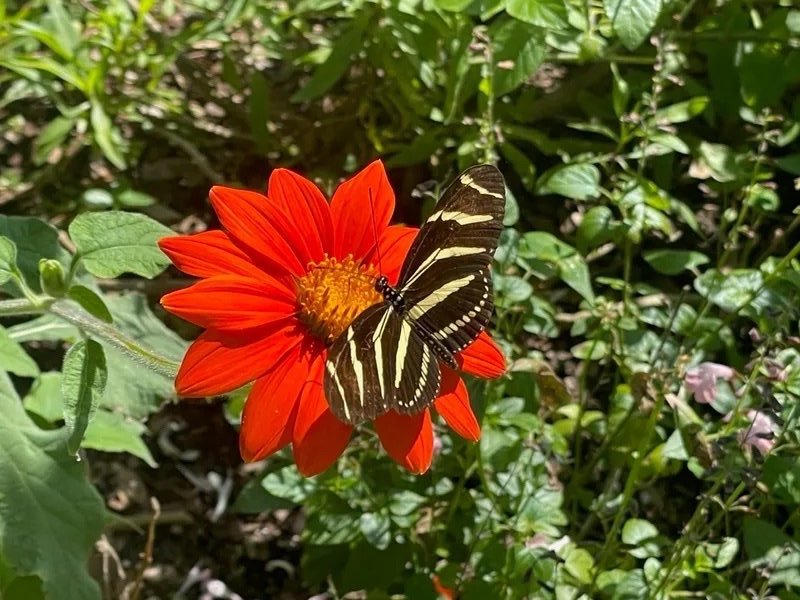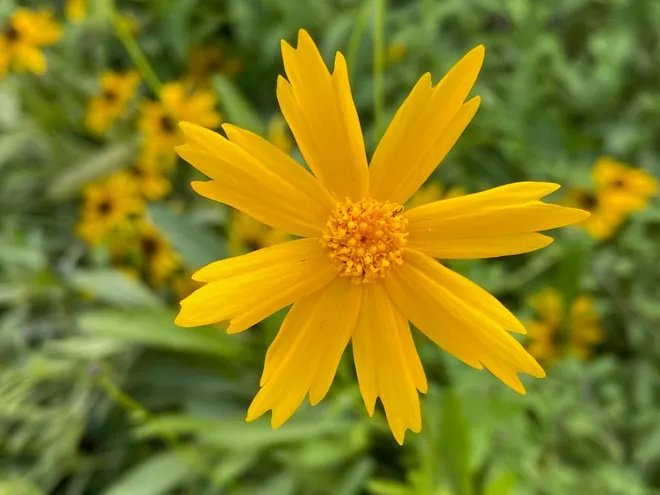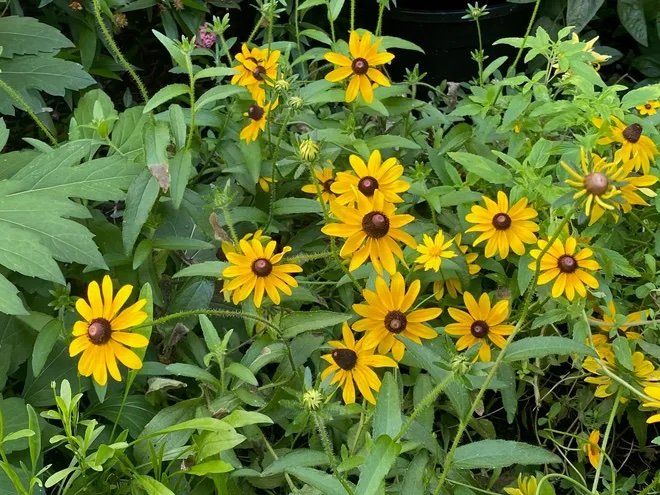Planting native plants is smart, and saves precious water
A zebra heliconian stops on a Mexican sunflower (Tithonia rotundifolia).
March 23, 2023
We’ve discussed the importance of native plants for the sustenance they provide our birds and butterflies, and for the habitat they afford local wildlife.
But planting natives is also just smart landscaping: Natives need much less water than more commonly used exotic annuals such as impatiens, begonias and coleus, and natives help regenerate and restore the soil. Their deeper, more expansive root systems retain micronutrients and their dense coverage protects from wind, sun and heavy rain.
Healthy soil is critical for life on earth, not just for our plants and food crops but for its ability to absorb rainfall, to break down waste and to store carbon — not just a little carbon, but trillions of tons of carbon. And while we rarely consider our soil, it is not an unlimited resource.
We lose billions of tons of fertile soil to erosion each year, and we are poisoning what remains with unnecessary chemicals in the form of pesticides and fertilizers that kill soil microorganisms essential to healthy plant growth. We are so focused on energy consumption causing climate change that we don’t see the huge impact our chemically reliant methods of plant and food production are having on our health and climate.
In a nutshell, synthetic chemicals destroy soil’s ability to function. This results in less nutrients in our plants and food, less sequestration of carbon from our air, and a significant increase in debilitating health issues for our children, our pets and ourselves. Not to mention that these chemicals are killing the insect pollinators all plants, wildlife and humans need to survive.
The problem with impatiens
But getting back to those annuals: I visited a garden last week whose owner was intent on planting natives, but his walkway was bordered with impatiens. This was not surprising; impatiens are ubiquitous for their colorful displays. But on closer inspection, I noticed that half the plants were wilted and looked terrible. So here are a few facts that landscapers neglect to mention as they load your borders and encircle your specimen trees with impatiens and other annuals.
These water-demanding plants are totally incompatible with other native plantings, and while they look great up north in cooler climes, they struggle to survive for even a few months in South Florida’s winter landscape. Impatiens and begonias need twice as much water as their native counterparts so adjacent plantings often suffer from root rot, fungal disease or mildew caused by the excess moisture. And if these annuals don’t have daily watering or have too much sun, they droop and wilt.
One of the worst examples of improper landscaping is the common practice of planting annuals around the base of date palms. The beautiful exotic date palm hails from northern Africa, where annual rainfall is about 15-20 inches. They are already at a disadvantage in South Florida where rainfall can reach 60 inches. Now add the sprinklers needed to keep the impatiens alive at their bases and you have a recipe for disaster.
And this is on top of the fact that water usage in Florida is already at a premium. We have just been alerted that Palm Beach County is in an official state of drought, with less than an inch of rain recorded since the beginning of the year.
I agree that impatiens are beautiful and they make a great addition to some areas, but let’s try moderation; these need not be the go-to for all condominiums, country clubs and homeowners.
Adding color to your borders
Leavenworth’s tickseed (Corepsis leavenworthii) is the state wildflower.
If you want color along a sunny border, try our native Leavenworth's tickseed (Coreopsis leavenworthii), which happens to be Florida’s state wildflower and which will reward you with an abundance of glorious yellow flowers while attracting butterflies and other pollinators.
Blue mistflower is loved by butterflies.
Blue mistflower (Conoclinum coelestinum) is another sun-loving native with beautiful pale blue flowers also loved by butterflies.
Beach verbena (Glandularia maritima) will provide wonderful lavender-purple flowers in sunny areas and is drought-and salt-tolerant.
Beach verbena is drought-and salt-tolerant.
Black-eyed Susan is one of the hardiest native flowers you can plant.
Black-eyed Susan (Rudbeckia hirta) is a tough-as-nails native for bright color. Cheerful yellow daisy-like flowers with black centers appear year-round and make great cut flowers as well. Butterflies come for the nectar and birds like the seeds. In shadier spots, try Tradescantia ohiensis, commonly called spiderwort. This low-care, drought-tolerant perennial boasts clusters of beautiful pale blue-to-lavender flowers atop a mound of lovely grasslike foliage.
The spiderwort (Tradescantia ohioensis) offers clusters of beautiful pale-to-lavender flowers.
Wild petunia (Ruellia succulenta) is endemic to South Florida and is the larval host plant for the rare and beautiful green malachite butterfly as well as the common buckeye. This lovely trouble-free perennial forms low mounds of leaves with stunning lavender blue or sometimes pink flowers. It prefers full sun but I have had success in areas with morning shade. The flowers are about 2 inches across and funnel-shaped; it’s fun to watch skippers crawl down the throats for nectar.
Wild petunia Is the larval host plant for the rare and beautiful green malachite butterfly.
Ruellia Caroliniensis has similar flowers and is also readily available at native nurseries. Please be careful to avoid the widely grown Mexican petunia (Ruellia simplex or R. brittoniana), as this reproduces via underground rhizomes and is listed as a category 1 invasive species.
Stokes aster is a flowering perennial.
Another great native for color is stokes aster (Stokesia laevis), one of our most beautiful flowering perennials. With enormous deep-blue flower heads, 2 to 4 inches across, above mounds of attractive evergreen foliage, this never fails to delight. It makes a great border plant, attracting numerous butterflies and pollinators.
This performs best in partly sunny locations with moist soil and requires little care once established. It provides excellent cut flowers that will last up to a week in arrangements, if you can bear to remove it from your garden.
Bushy aster (Symphyotrichum dumosum) is a vigorous spreading ground cover with an abundance of lavender pink flowers with yellow centers. This is the host plant for the pearl crescent and is a butterfly magnet in general. It prefers full sun but is fine in light shade. Give it some moisture to become established; afterward, it needs little care.
I also want to mention Mexican sunflower (Tithonia rotundifolia) for its spectacular orange red flowers that light up any sunny garden from spring through fall. There is some debate as to whether this is a true native; regardless, this vigorous bushy annual will certainly bring an abundance of butterflies, pollinators and hummingbirds to your landscape. Vigorous and drought-tolerant, this will grow 3 to 5 feet in even poor sandy soil.
HOME-GARDEN
Green gardening: Planting native plants is smart, and saves precious water
Kim Frisbie
Special to the Daily News
We’ve discussed the importance of native plants for the sustenance they provide our birds and butterflies, and for the habitat they afford local wildlife.
But planting natives is also just smart landscaping: Natives need much less water than more commonly used exotic annuals such as impatiens, begonias and coleus, and natives help regenerate and restore the soil. Their deeper, more expansive root systems retain micronutrients and their dense coverage protects from wind, sun and heavy rain.
Healthy soil is critical for life on earth, not just for our plants and food crops but for its ability to absorb rainfall, to break down waste and to store carbon — not just a little carbon, but trillions of tons of carbon. And while we rarely consider our soil, it is not an unlimited resource.
We lose billions of tons of fertile soil to erosion each year, and we are poisoning what remains with unnecessary chemicals in the form of pesticides and fertilizers that kill soil microorganisms essential to healthy plant growth. We are so focused on energy consumption causing climate change that we don’t see the huge impact our chemically reliant methods of plant and food production are having on our health and climate.
In a nutshell, synthetic chemicals destroy soil’s ability to function. This results in less nutrients in our plants and food, less sequestration of carbon from our air, and a significant increase in debilitating health issues for our children, our pets and ourselves. Not to mention that these chemicals are killing the insect pollinators all plants, wildlife and humans need to survive.
The problem with impatiens
But getting back to those annuals: I visited a garden last week whose owner was intent on planting natives, but his walkway was bordered with impatiens. This was not surprising; impatiens are ubiquitous for their colorful displays. But on closer inspection, I noticed that half the plants were wilted and looked terrible. So here are a few facts that landscapers neglect to mention as they load your borders and encircle your specimen trees with impatiens and other annuals.
These water-demanding plants are totally incompatible with other native plantings, and while they look great up north in cooler climes, they struggle to survive for even a few months in South Florida’s winter landscape. Impatiens and begonias need twice as much water as their native counterparts so adjacent plantings often suffer from root rot, fungal disease or mildew caused by the excess moisture. And if these annuals don’t have daily watering or have too much sun, they droop and wilt.
One of the worst examples of improper landscaping is the common practice of planting annuals around the base of date palms. The beautiful exotic date palm hails from northern Africa, where annual rainfall is about 15-20 inches. They are already at a disadvantage in South Florida where rainfall can reach 60 inches. Now add the sprinklers needed to keep the impatiens alive at their bases and you have a recipe for disaster.
And this is on top of the fact that water usage in Florida is already at a premium. We have just been alerted that Palm Beach County is in an official state of drought, with less than an inch of rain recorded since the beginning of the year.
I agree that impatiens are beautiful and they make a great addition to some areas, but let’s try moderation; these need not be the go-to for all condominiums, country clubs and homeowners.
Adding color to your borders
If you want color along a sunny border, try our native Leavenworth's tickseed (Coreopsis leavenworthii), which happens to be Florida’s state wildflower and which will reward you with an abundance of glorious yellow flowers while attracting butterflies and other pollinators.
Blue mistflower (Conoclinum coelestinum) is another sun-loving native with beautiful pale blue flowers also loved by butterflies.
Beach verbena (Glandularia maritima) will provide wonderful lavender-purple flowers in sunny areas and is drought-and salt-tolerant.
Black-eyed Susan (Rudbeckia hirta) is a tough-as-nails native for bright color. Cheerful yellow daisy-like flowers with black centers appear year-round and make great cut flowers as well. Butterflies come for the nectar and birds like the seeds. In shadier spots, try Tradescantia ohiensis, commonly called spiderwort. This low-care, drought-tolerant perennial boasts clusters of beautiful pale blue-to-lavender flowers atop a mound of lovely grasslike foliage.
Wild petunia (Ruellia succulenta) is endemic to South Florida and is the larval host plant for the rare and beautiful green malachite butterfly as well as the common buckeye. This lovely trouble-free perennial forms low mounds of leaves with stunning lavender blue or sometimes pink flowers. It prefers full sun but I have had success in areas with morning shade. The flowers are about 2 inches across and funnel-shaped; it’s fun to watch skippers crawl down the throats for nectar.
Ruellia Caroliniensis has similar flowers and is also readily available at native nurseries. Please be careful to avoid the widely grown Mexican petunia (Ruellia simplex or R. brittoniana), as this reproduces via underground rhizomes and is listed as a category 1 invasive species.
Another great native for color is stokes aster (Stokesia laevis), one of our most beautiful flowering perennials. With enormous deep-blue flower heads, 2 to 4 inches across, above mounds of attractive evergreen foliage, this never fails to delight. It makes a great border plant, attracting numerous butterflies and pollinators.
This performs best in partly sunny locations with moist soil and requires little care once established. It provides excellent cut flowers that will last up to a week in arrangements, if you can bear to remove it from your garden.
Bushy aster (Symphyotrichum dumosum) is a vigorous spreading ground cover with an abundance of lavender pink flowers with yellow centers. This is the host plant for the pearl crescent and is a butterfly magnet in general. It prefers full sun but is fine in light shade. Give it some moisture to become established; afterward, it needs little care.
I also want to mention Mexican sunflower (Tithonia rotundifolia) for its spectacular orange red flowers that light up any sunny garden from spring through fall. There is some debate as to whether this is a true native; regardless, this vigorous bushy annual will certainly bring an abundance of butterflies, pollinators and hummingbirds to your landscape. Vigorous and drought-tolerant, this will grow 3 to 5 feet in even poor sandy soil.
But this is one of those instances where it is very important to get the right species. Beware the similar yellow-flowered Tithonia diversifolia, also labelled Mexican sunflower, which is a rampant spreader and now listed as a class 1 invasive in Florida.
My kitchen window looks out onto a sabal palm (Florida’s state tree) and I love to watch the early morning light sparkle off the beautiful fronds, which have a stunning yellow stripe on the center fold. So I was startled the other morning when a pair of eyes stared back at me as I was inspecting the fronds.
Almost completely hidden in one of the protective “boots” of the tree was a nesting mourning dove, her coloring a perfect match for the palm’s lovely bark. Here’s another reason to abstain from removing these “boots,” which hold moisture and collect organic matter: they provide perfect nesting spots for birds and other creatures. If you have sabal palms, leave the boots on; they provide habitat for birds and look great as well.
Finally, I would like to applaud Kathleen Mara for her wonderful letter to the editor in last week’s paper. Her description of her personal journey in exchanging exotic species for natives, foregoing pesticides and chemicals, and thereby inviting butterflies and birds back to her garden is truly inspirational. If we all make just a few simple changes to our landscapes and lifestyles, we too can bring real South Florida gardens back to Palm Beach. Thanks, Kathleen!








